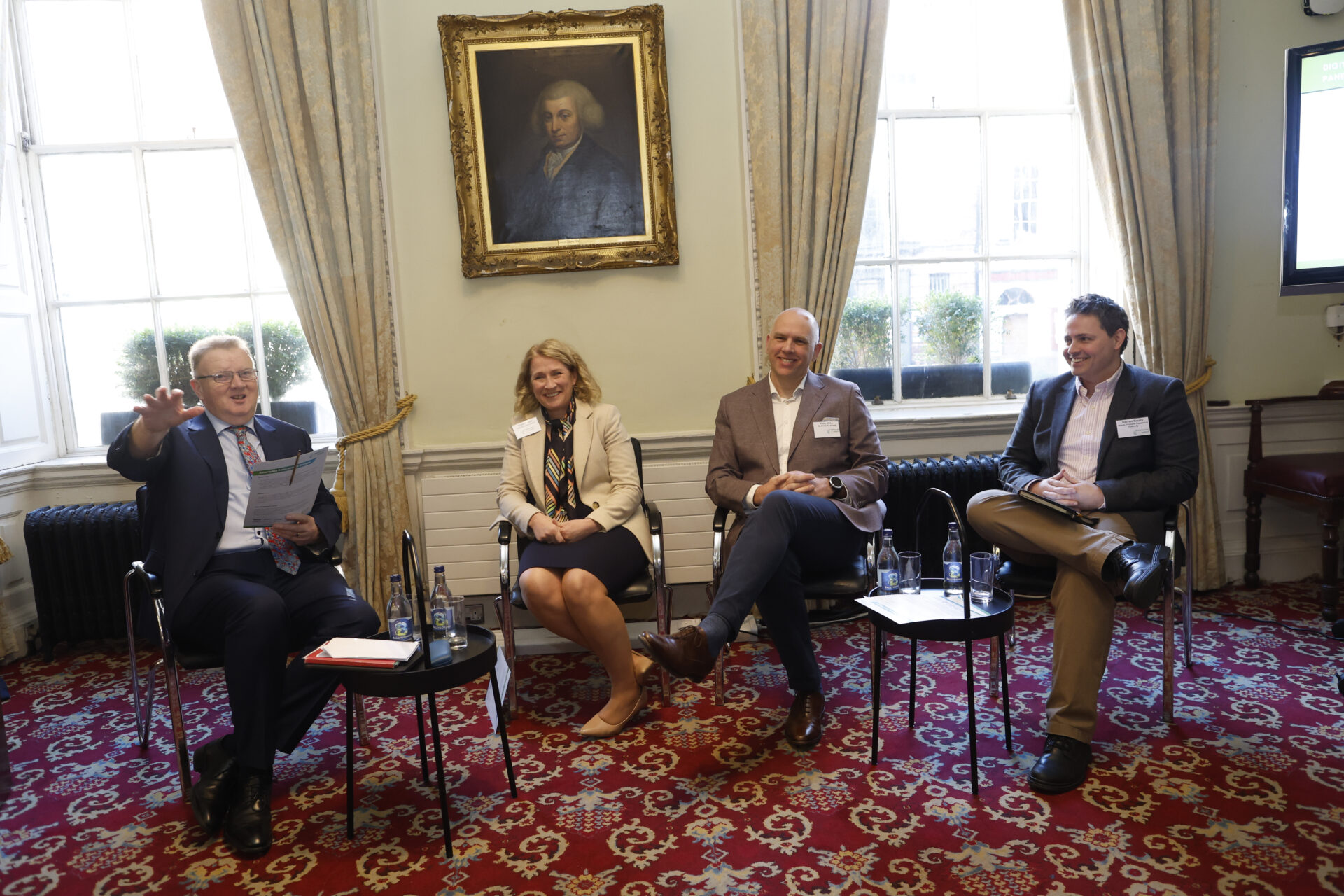Home » The transition to digital-first communications
Medicines for Ireland recently held an event that focused on the transition to digital-first safety communications, improving environmental impact and ending wasteful duplication of resources. Chairperson Paul Neill provides an overview of the event in this article.

In the healthcare sector, effective communication regarding the risks and benefits of medicines is paramount to ensuring the safety and wellbeing of patients. One critical aspect of this communication is the dissemination of safety information to healthcare professionals.
On 12 March, Medicines for Ireland (MFI), the representative body for the generic, biosimilar, and value-added medicines sector, hosted a breakfast briefing event, ‘Digital Solutions for a Greener Industry’, in the Royal Irish Academy, calling for the transition to digital-first communication of safety materials to healthcare professionals.
The aim of the event was to bring together experts and representatives from across the healthcare sector to explore the benefits, opportunities, and challenges of transitioning to a digital-first model.
Data gathered by MFI from its members was presented on the day, showing members had printed over 1.2 million pages, or 6.3 metric tonnes, of mandated safety communications over the past three years. This resulted in costs of more than €700,000 for printing, storing, and distributing these safety communications to healthcare professionals.
Paper-based systems have served us well in the past, ensuring that healthcare professionals have access to the best information available at that time. However, given technological advancements, paper-based communication systems are now less efficient, environmentally more unsustainable and at higher risk of being outdated.
Deirdre Kelly opened the event, then Vice Chair of Medicines for Ireland, and detailed the current realities expressed by members while setting out the opportunities presented by the transition to digital-first communications. Ms Kelly introduced a video address by MEP Billy Kelliher, a long-standing advocate for all stakeholders in healthcare, who shared his support for the event and the discussion on how digital communications can enhance patient safety.
Guests in attendance represented various sectors, from industry, legislative and regulatory. We were expertly led throughout the morning by the event Chair, Prof. Pat O’Mahony, who, in his traditional style, made everyone in attendance feel at ease while bringing his own expert views to the discussion. Joining Prof. O’Mahony on the panel were MFI Chairperson, Paul Neill, IPU Head of Strategic Policy and PGEU President, Clare Fitzell and Darren Scully of the HPRA.
A lively, informative panel discussion took place where all participants agreed that ensuring patient safety is paramount. While there were different views on the best approach to transitioning from paper-based to digital safety communications, there is agreement to continue collaborating to improve the current system, as all stakeholders recognise it presents different challenges for all those who rely on it.
Digital-first communications can allow for instant access to updated/new information, reducing the risk of outdated materials and ensuring timely updates to healthcare professionals and patients. The current paper-based systems mean it takes months for new updates to be printed, packed, and distributed to healthcare professionals, leaving a window where the latest information is not available to healthcare professionals and patients.
It is also the case that healthcare professionals use digital communication channels on a daily basis for patient prescriptions, regulatory updates, and up-to-date clinical information. We can use those channels to get safety information out to them that is accessible, searchable and timely using the channel that HCPs typically use to receive other health related information. While it was accepted that digital channels are used now more than ever, there are some issues that have arisen since their introduction and so it is important to consider the entire cycle that healthcare professionals complete before prescribing or dispensing a medicine to a patient to understand when and how the safety information can be accessed effectively and efficiently.
The environmental benefits of digital communications are clear for all to see. The 6.3 metric tonnes of printed safety communications in the last three years are enough to cover over 11 football pitches. MFI and its members are committed to continuing to improve the industry’s environmental footprint, and while printed materials will always have a place within industry communication, MFI would like to see the current mandatory requirement reviewed.
It was acknowledged that the current paper-based system generates duplication and waste. It was also acknowledged that switching to digital communications would prevent duplication of efforts and costs resulting from preparing, printing and distributing multiple copies of the same information on a single molecule from different manufacturers. Efforts are being made to try to streamline this process by supporting MAHs to issue joint safety communications. While it is not a straightforward process given the competitive nature of the industry, it is welcome to see the regulator’s openness and willingness to introduce new approaches.
“Digital-first communications can allow for instant access to updated/new information, reducing the risk of outdated materials and ensuring timely updates to healthcare professionals and patients.”
As presented at the event, positive examples from across Europe show that the digital evolution is already underway. Many countries, including Finland, Portugal, the Netherlands, and Latvia, do not mandate hard copy distribution of safety materials aimed at healthcare professionals. Furthermore, Poland accepts the dissemination of digital materials via email to target healthcare professionals.
In the Netherlands, the policy for additional risk minimisation measures (aRMM) is that if the innovator has already disseminated materials, generic companies are required to publish aRMM materials on their company websites, but no physical hard copy cover letter is required. During the event, another example of a pilot study by the Swedish Medicines Agency to deliver urgent drug safety information to prescribers through their digital mailboxes was shared. If successful, this pilot may pave the way for a permanent digital system.
All panellists agreed that a collaborative approach is required to progress from the current model to a digital-first method of communication. The ongoing eDHPC project will give us a deeper understanding of the positive and challenging realities presented by sending safety communications to healthcare professionals using digital channels. This project will see some DHPCs sent via email to healthcare professionals and others sent by digital and postal channels. Healthcare professionals will be asked for their feedback, and we will use the learnings from this pilot project to improve the next iteration of digital safety communications and continue working in collaboration with the regulator, the healthcare professionals and the wider industry to enhance patient safety while reducing our impact on the environment.
In Ireland, the momentum towards digital health is accelerating. Milestones of note include the recent launch of the HSE patient app and a successful pilot of electronic health records for patients, with a commitment to wider expansion in line with the Digital Health Strategy. Furthermore, the HSE is moving progressively towards a default position of communication by text or email rather than by post. The digital and green transition is underway, and while this is a relatively small advancement in comparison to others on the agenda, it can have a significant impact in improving patient safety and our environmental impact.
The event served as a starting point for bringing different stakeholders together to discuss how digital channels that are faster and more accessible than current methods can benefit healthcare professionals and patients. It succeeded in shining a light on some of the challenges that exist, but most importantly, it demonstrated the willingness of all stakeholders to constructively contribute to the process of transitioning to digital communications, once enhanced patient safety continues to be the north star that guides this journey.

Reflecting on the event, Clare Fitzell, Pharmacist and Head of Strategic Policy at the IPU, noted the alignment between the MFI and IPU agendas, particularly the shared ambition to eliminate paper and move towards a more digital and paper free environment.
A key takeaway she highlighted was the importance of reflection as we move into a more digital space. It is not enough to simply replicate paper processes in a digital format; we must consider whether this genuinely improves patient care. Any move towards digital solutions should take into account existing healthcare workflows, especially in areas where clinical decisions are being made, and use the opportunity to enhance patient outcomes and the safety of medicines information.
Paul Neill

Chairperson, Medicines for Ireland
Highlighted Articles